Now that the calendar has turned from May to June, we have truly entered the breeding season for most Maryland birds–and most wildlife, in general. Depending on how far they traveled this spring and how long they’ve been back to set up territories, some species are building nests, others laying eggs, for some, young are already hatching, and, in a few cases, parents are already teaching their fledglings to learn basic feeding and survival skills in the dangerous world of nature. With just a few exceptions, avian migration has come to an end; for the next 6-8 weeks, pretty much any bird you encounter is here to find a mate and settle down (as much as birds do) to raise a family in the Baltimore area.
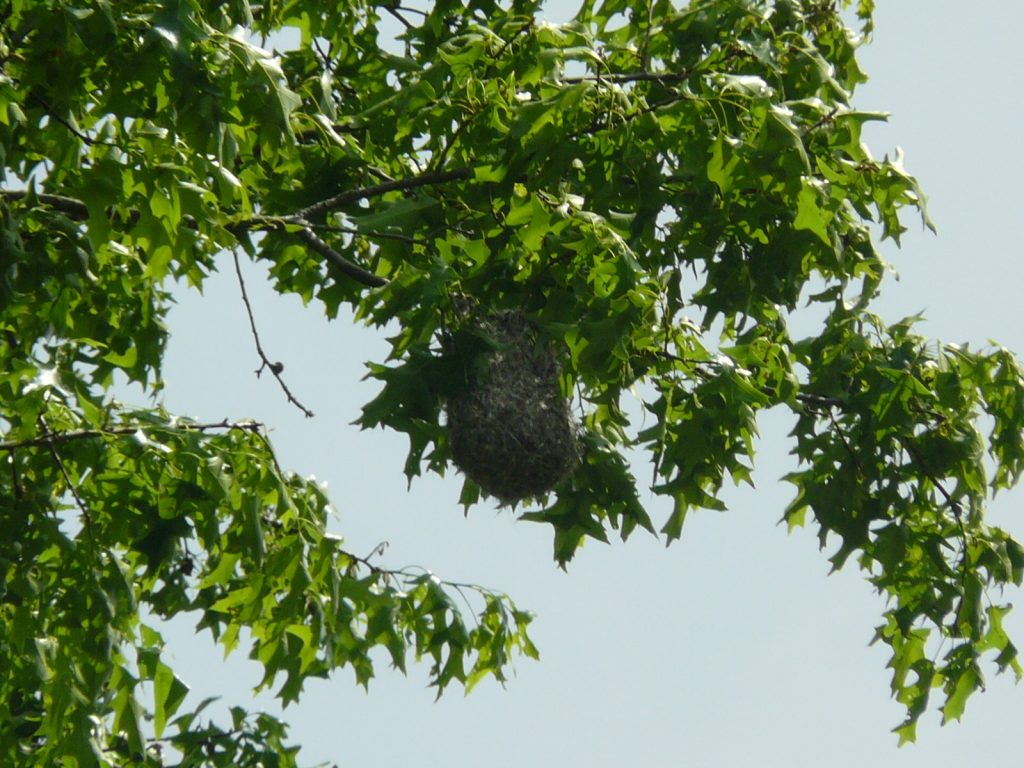 It’s been great to experience my first nesting season at Irvine. My son and I have walked most of the trails over the past week or two; just the other morning, we discovered an active Baltimore Oriole nest and watched the female weaving final strands of grass into her masterpiece; earlier we stumbled upon an American Robin nest with four wide-open mouths, begging to be fed. The wetlands are abuzz with the resounding ‘gungaree’ of Red-winged Blackbirds and the more melodic territorial declarations of Song Sparrows. The drier grasslands echo with the ‘witchety-witchety-witchety’ song of Common Yellowthroats and the fast-spinning coin-like trill of Field Sparrows. Soft rising songs of Eastern Wood-Pewees complement the ethereal flute-like phrases of Wood Thrushes in the deciduous forest. But, of course, the bulk of the action is at the edges, where meadow meets woods, where mature forest meets overgrown field. That’s where one finds most of the more common ‘generalist’ species: Carolina Wrens, Gray Catbirds, Brown Thrashers, White-eyed Vireos, Eastern Towhees, Indigo Buntings, and the ever-popular Bluebirds and Orioles.
It’s been great to experience my first nesting season at Irvine. My son and I have walked most of the trails over the past week or two; just the other morning, we discovered an active Baltimore Oriole nest and watched the female weaving final strands of grass into her masterpiece; earlier we stumbled upon an American Robin nest with four wide-open mouths, begging to be fed. The wetlands are abuzz with the resounding ‘gungaree’ of Red-winged Blackbirds and the more melodic territorial declarations of Song Sparrows. The drier grasslands echo with the ‘witchety-witchety-witchety’ song of Common Yellowthroats and the fast-spinning coin-like trill of Field Sparrows. Soft rising songs of Eastern Wood-Pewees complement the ethereal flute-like phrases of Wood Thrushes in the deciduous forest. But, of course, the bulk of the action is at the edges, where meadow meets woods, where mature forest meets overgrown field. That’s where one finds most of the more common ‘generalist’ species: Carolina Wrens, Gray Catbirds, Brown Thrashers, White-eyed Vireos, Eastern Towhees, Indigo Buntings, and the ever-popular Bluebirds and Orioles.
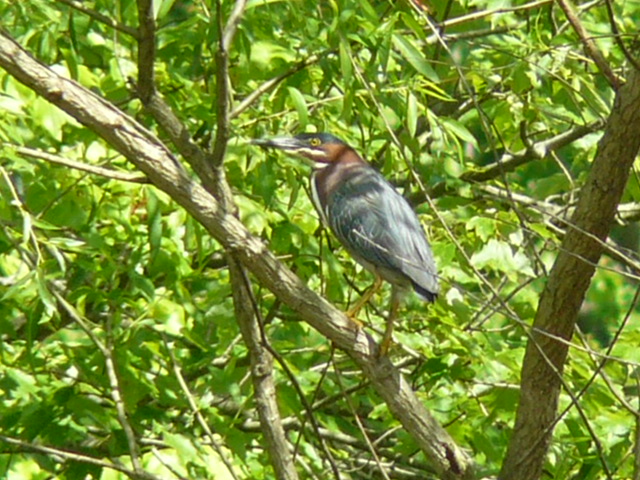 One of our best trails for experiencing this vast array of ‘edge birds’ seems to be the Green Heron Trail, which winds
One of our best trails for experiencing this vast array of ‘edge birds’ seems to be the Green Heron Trail, which winds 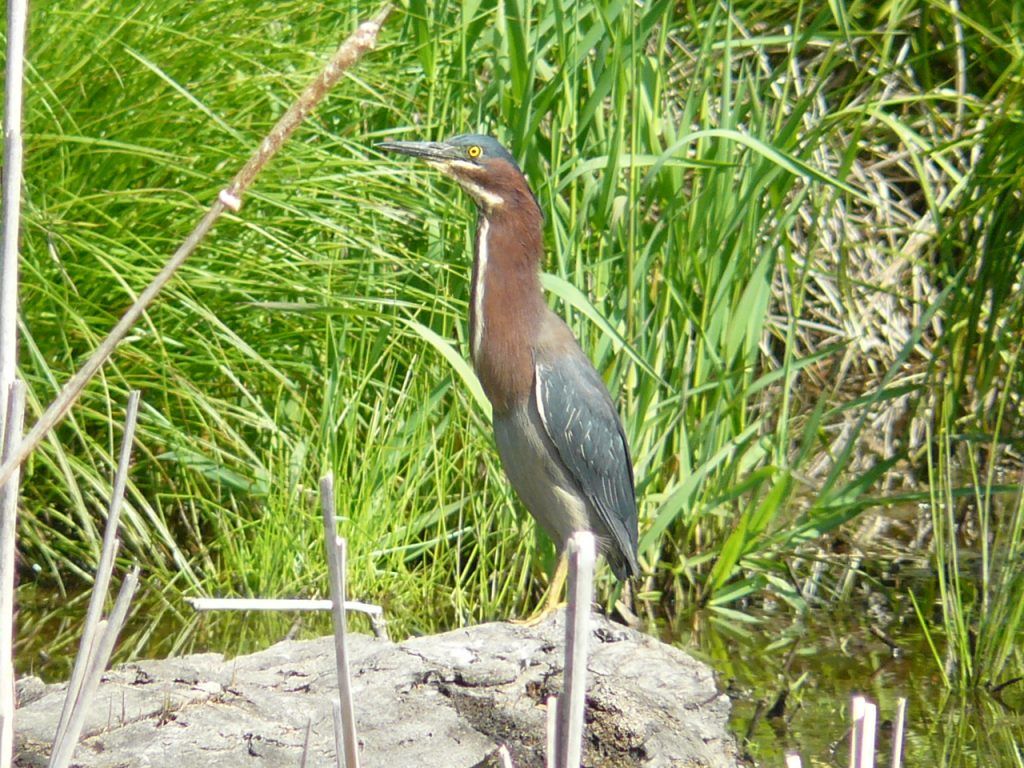 throughout the northwest corner of our property, at times wandering through wetter, low-lying areas of forest, where tulip poplars grow tall and straight, while also skirting the meadows that surround our three westernmost ponds. This, of course, is where one often encounters–at least during the warmer half of the year–the shy pair of herons after whom the trail is named. Although they usually return to the area in early May, I had my first run-in with them about two weeks ago. Despite how quiet the trails have been recently, neither bird seemed very skittish as I approached; one flew maybe forty or fifty feet to a nearby tree but perched only ten feet up. The other simply climbed out of the pond, onto a nearby log and watched me cautiously, as I got within ten or twelve paces of it. Their calmer-than-usual reaction provided more evidence for the growing argument that nature has flourished this spring in our absence and hasn’t really missed us one bit.
throughout the northwest corner of our property, at times wandering through wetter, low-lying areas of forest, where tulip poplars grow tall and straight, while also skirting the meadows that surround our three westernmost ponds. This, of course, is where one often encounters–at least during the warmer half of the year–the shy pair of herons after whom the trail is named. Although they usually return to the area in early May, I had my first run-in with them about two weeks ago. Despite how quiet the trails have been recently, neither bird seemed very skittish as I approached; one flew maybe forty or fifty feet to a nearby tree but perched only ten feet up. The other simply climbed out of the pond, onto a nearby log and watched me cautiously, as I got within ten or twelve paces of it. Their calmer-than-usual reaction provided more evidence for the growing argument that nature has flourished this spring in our absence and hasn’t really missed us one bit.
This was easily the closest I’ve been to a Green Heron since one of my most memorable birding moments ever. It was nearly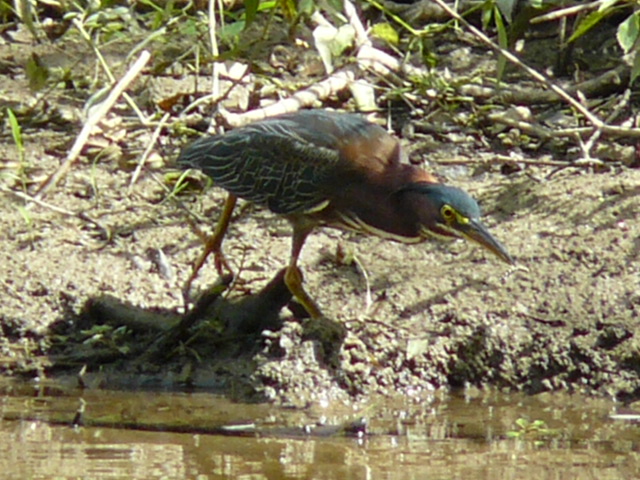 two years ago, in September of 2018, and I was birding along the red trail at Lake Roland. That trail has a lot of similarities with our Green Heron trail, as it follows the forest edge and allows occasional nice views of the adjacent wetlands. It was a beautiful early fall weekend, and I paused mid-hike to appreciate the sunshine and lakeside breeze. It was so pleasant that I
two years ago, in September of 2018, and I was birding along the red trail at Lake Roland. That trail has a lot of similarities with our Green Heron trail, as it follows the forest edge and allows occasional nice views of the adjacent wetlands. It was a beautiful early fall weekend, and I paused mid-hike to appreciate the sunshine and lakeside breeze. It was so pleasant that I 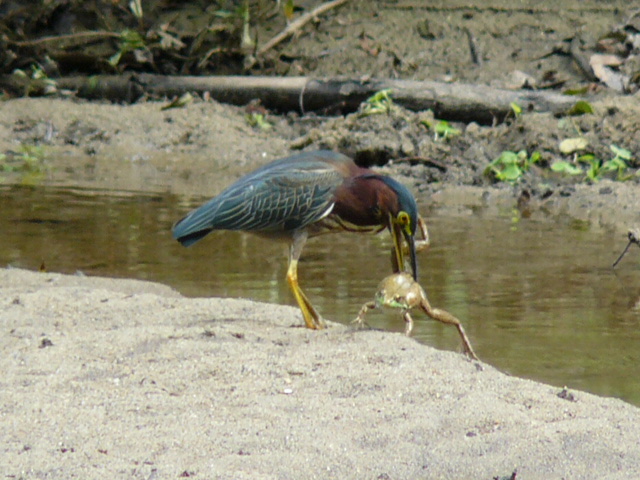 chose to plop myself down on a fallen log, near the shoreline. Not two minutes later, a Green Heron tiptoed out of some dense vegetation and gingerly walked right in my direction. It hesitated at the waters edge and was clearly tracking something, although I couldn’t tell what. Suddenly, with lightning fast speed, the patient hunter thrust forward that sharp beak and emerged from the water holding a prey item so large I couldn’t help but gasp! Green Herons used to be called Little Green Herons for good reason: they’re only about 17 inches tall (roughly 1/3 the height of a Great Blue) and weigh less than a pound. This diminutive wading bird had somehow stalked and caught a full-grown American Bullfrog, which, legs and all, was over half its size and likely weighed almost as much as the heron!
chose to plop myself down on a fallen log, near the shoreline. Not two minutes later, a Green Heron tiptoed out of some dense vegetation and gingerly walked right in my direction. It hesitated at the waters edge and was clearly tracking something, although I couldn’t tell what. Suddenly, with lightning fast speed, the patient hunter thrust forward that sharp beak and emerged from the water holding a prey item so large I couldn’t help but gasp! Green Herons used to be called Little Green Herons for good reason: they’re only about 17 inches tall (roughly 1/3 the height of a Great Blue) and weigh less than a pound. This diminutive wading bird had somehow stalked and caught a full-grown American Bullfrog, which, legs and all, was over half its size and likely weighed almost as much as the heron!
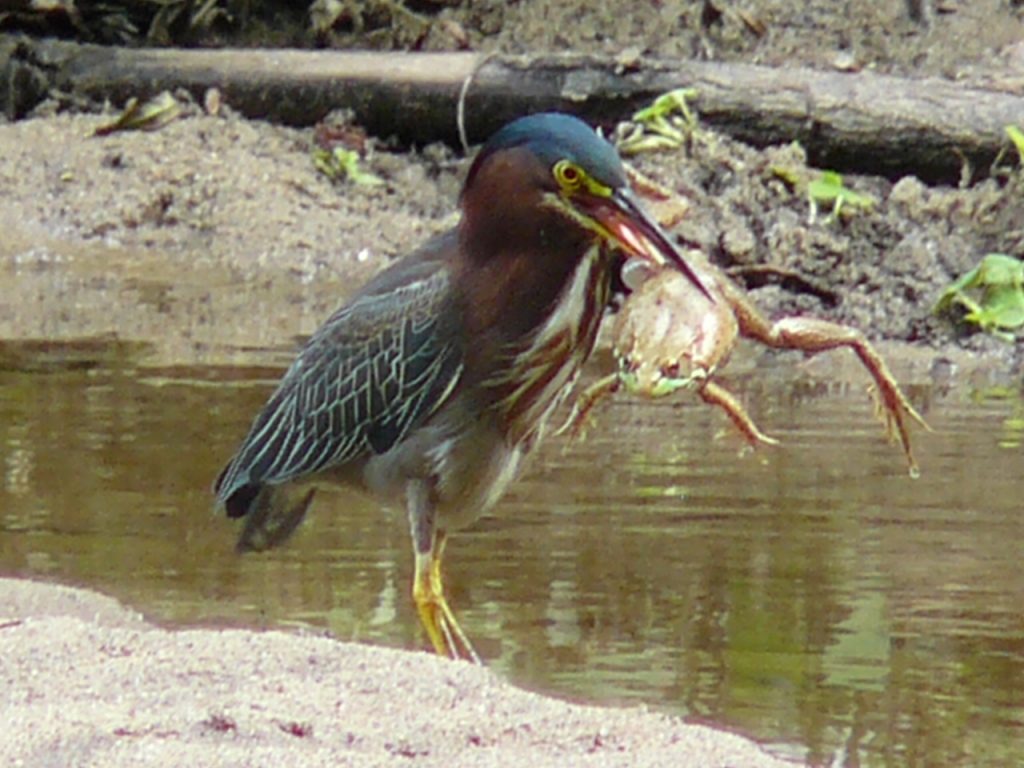
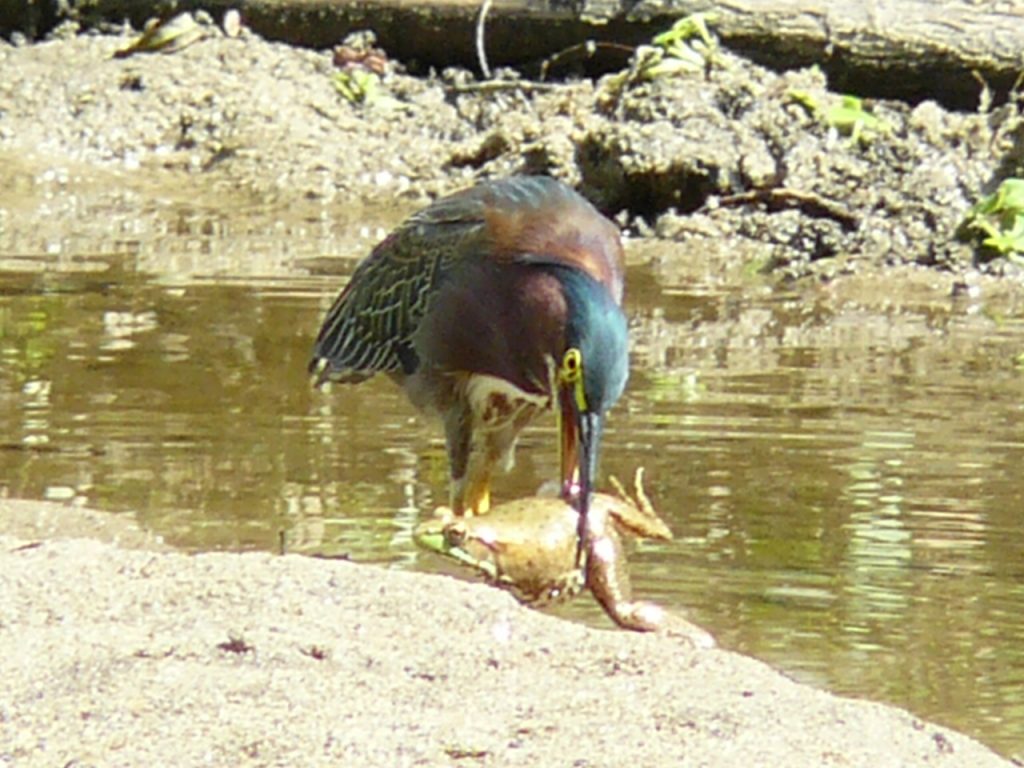
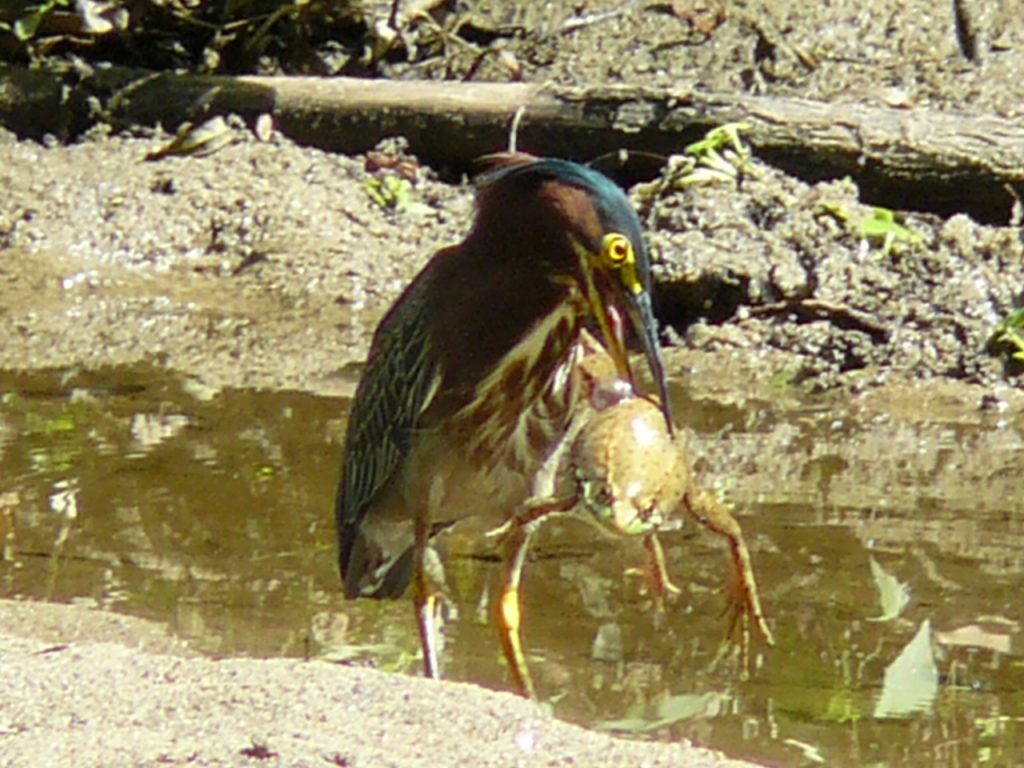
What followed was one of the most amazing predator-prey battles I’ve ever witnessed. It took no less than fourteen minutes for the heron to finally subdue the bullfrog, and there were several near-escapes during that time, as the heron had to keep repositioning its enormous kicking prize so as to get a better grasp with its long beak. In their struggle, neither organism cared that I was sitting just 25 feet away, snapping picture after picture and not believing my good fortune to be witnessing such a rare event from a ringside seat! Finally a sharp pierce to the abdomen brought an end to the bullfrog’s resistance and it went limp in the vise grip of the heron’s bill.

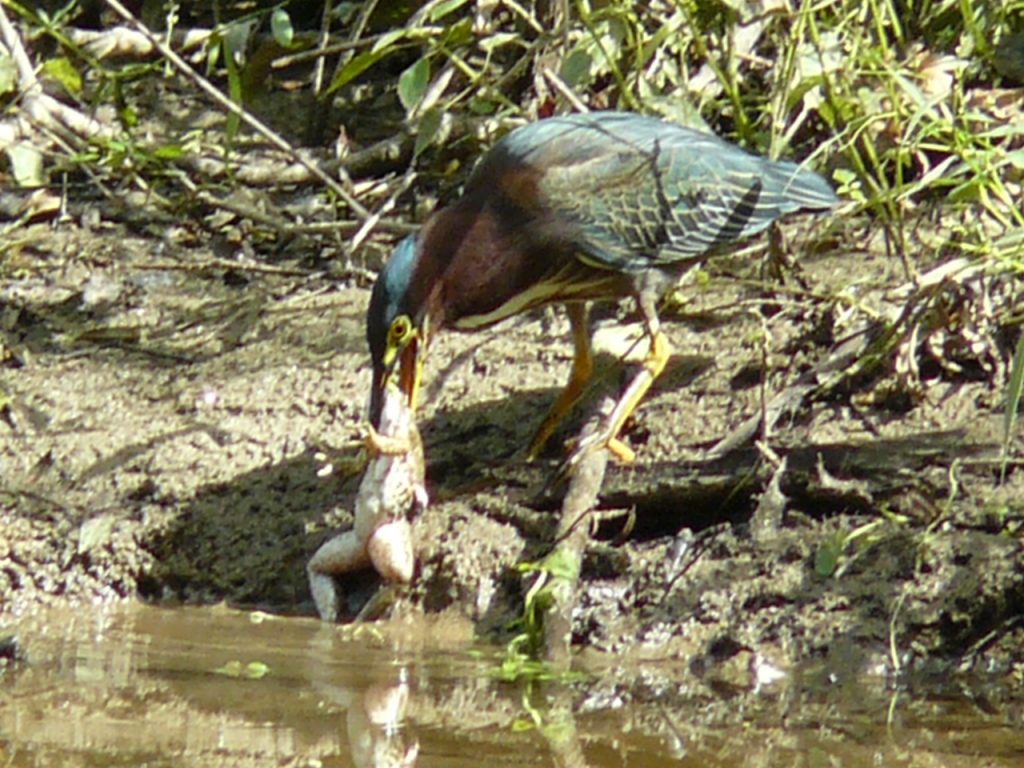
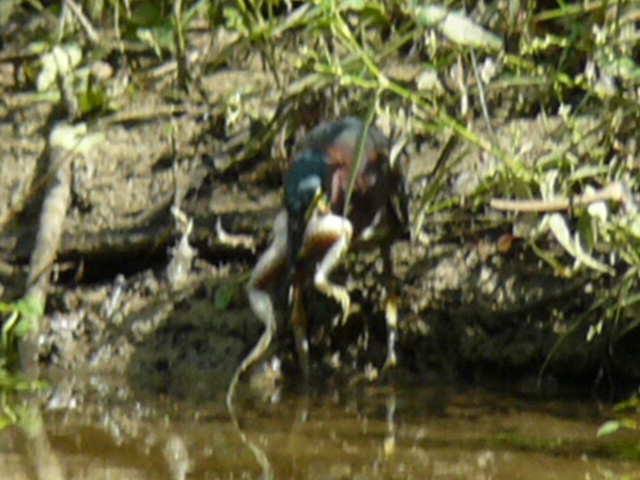
Clearly exhausted from this seemingly endless confrontation, the heron stood motionless for a time, regaining its bearings and choosing its next course of action. Suddenly self-conscious–or, more likely, fearful that it might lose the prize for which it had fought so valliantly, its first move was to drag the massive amphibian through the shallow water and over to the farther shoreline, another five or six feet from me. If I may get just a bit anthropomorphic, the heron seemed to be looking at me with a ‘Don’t you even think about it . . . ‘ expression–as if watching every move of that grotesque, drawn-out scuffle hadn’t completely ruined my appetite. And, no offense to my Francophone wife, but I’ve never had much of a palate for frog’s legs in the first place.
It took the heron another five minutes to manipulate the bullfrog into just the right position to be able to swallow it whole, head-first and belly-up. At first it didn’t seem possible for the bird to force down a prey item that was clearly much bigger than its own oral cavity; in fact, the heron seemed to gag a few times. But, reminiscent of a snake eating a rodent, the heron’s esophagus somehow expanded to allow it and, thanks to the bird’s strong throat muscles, the huge lunch began working its way down the heron’s thin neck. I could literally see the bulge of the bullfrog slowly progressing downward, making one part of the heron’s throat significantly wider than elsewhere. When it appeared that the long-legged amphibian had finally reached its destination, I expected the heron to take off, but I was clearly naïve. This was no ordinary lunch. This frog was probably one of the biggest meals–if not the biggest–ever devoured by this particular bird, and it wasn’t going down smoothly. The heron literally stayed put for another five minutes, neck outstretched and beak pointing upward, as if any extra stretching of the throat might help get the frog to its stomach and keep it there! In all, this event lasted almost half an hour, and I was mesmerized the entire time.
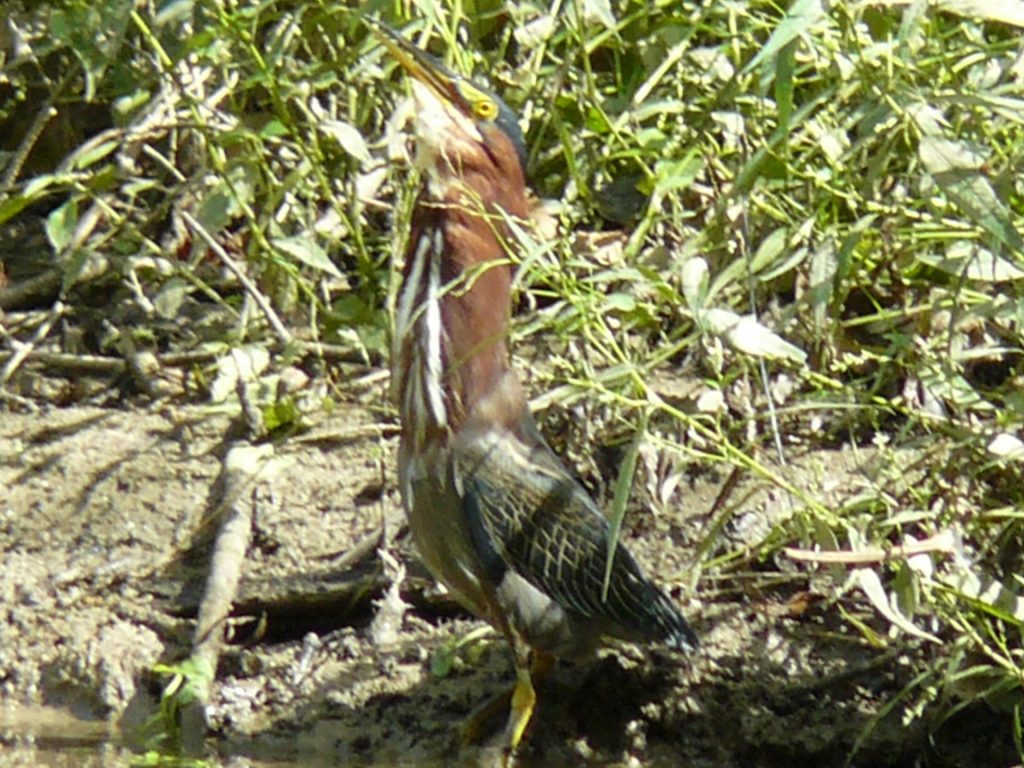 Are Green Herons unusual around here? Nope, nor are bullfrogs. Neither of the species involved would be considered rare, but seeing that encounter between them unfolding right in front of me definitely was. The convergence of all three of us at just that moment created a nature experience that is indelibly written into my memory, and I feel very fortunate to have witnessed it. In an odd sort of way, I even find it fitting, given the interconnectedness of ecological systems and the yin and yang duplicity that seems to underlie most interactions between organisms, that in order for me (and the Green Heron!) to have that awesome experience, the poor bullfrog had to find himself in the wrong place at the wrong time! I’m sure all of us have such memorable moments in nature; the best ones come completely unexpectedly, in random places, and at unpredictable times. The only thing one can do to make them more likely to occur is to spend as much time outdoors as possible–in places where wildlife is abundant . . . like Irvine Nature Center! As we get ready to reopen the property after several months closed, I wish for all of you to find yourself in the right place at the right time this summer so you create a ‘forever memory’ in nature. Welcome back to Irvine! We’ve missed you. –BR
Are Green Herons unusual around here? Nope, nor are bullfrogs. Neither of the species involved would be considered rare, but seeing that encounter between them unfolding right in front of me definitely was. The convergence of all three of us at just that moment created a nature experience that is indelibly written into my memory, and I feel very fortunate to have witnessed it. In an odd sort of way, I even find it fitting, given the interconnectedness of ecological systems and the yin and yang duplicity that seems to underlie most interactions between organisms, that in order for me (and the Green Heron!) to have that awesome experience, the poor bullfrog had to find himself in the wrong place at the wrong time! I’m sure all of us have such memorable moments in nature; the best ones come completely unexpectedly, in random places, and at unpredictable times. The only thing one can do to make them more likely to occur is to spend as much time outdoors as possible–in places where wildlife is abundant . . . like Irvine Nature Center! As we get ready to reopen the property after several months closed, I wish for all of you to find yourself in the right place at the right time this summer so you create a ‘forever memory’ in nature. Welcome back to Irvine! We’ve missed you. –BR
